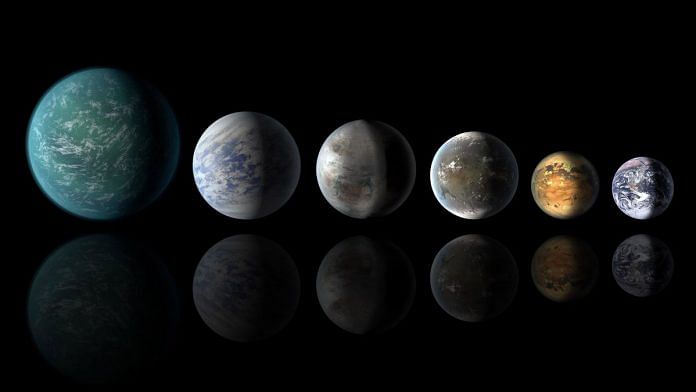Astronomers discover 18 new earth-sized exoplanets
Astronomers using the Kepler Space Telescope and a new, more sensitive algorithm have discovered 18 new earth-sized exoplanets. Their sizes range from 60 per cent of the earth to double.
Using new algorithms, it is expected that astronomers would find over 100 new exoplanets in existing Kepler data, bringing the number of exoplanets discovered to nearly 4,100. More on Earth Sky.
Unusual fossil captures school of 259 fish
A 50 million-year-old fossil embedded in limestone shale shows what looks like a school of 259 fish swimming. It is highly unusual as most fish fossils tend to be individual or groups of animals having died and been buried in sediment. This one appears to have caught group behaviour mid-action. More on The Atlantic.
Radiation leaking into animals from US nuclear test dump site
After nuclear testing during the peak of the Cold War, the United States got rid of its nuclear waste in dumping grounds in the waters near the Marshall Islands, between Australia and Hawaii. New findings from the region show that there are high levels of radiation in giant clams in the water. The radiation could either be leaking from the nuclear waste stored there or could potentially be a residue from the half-a-century old tests themselves. More on LA Times.
Climate crisis is now affecting yields of global crops
The world’s top 10 crops have seen a significant variation in yield over the past few years, ranging from a 13.4 per cent decrease for oil palm to a 3.5 per cent increase for soybean. The cause can be directly traced to human-induced climate change. Developing nations as well as affluent ones, such as many in Western Europe, are facing food shortages that are only expected to worsen. More on Phys.
Bonus: NASA’s Solar and Heliospheric Observatory captures a massive solar prominence
This time lapse shows a prominent solar flare that is caused as a result of the tangling of the magnetic field on the sun.
A truly massive solar prominence, captured here in the UV by NASA's Solar Dynamics Observatory. This is the result of the sun's magnetic field lines getting tangled and reconnecting along loops, which you can kinda see in this 90-minute timelapse. pic.twitter.com/nCqs56clgt
— Anna Hughes (@AnnaGHughes) May 26, 2019
Also read: Earthworms: A fresh challenge in the fight against global warming




Only we can understand that there are life on other planets but we can not even communicate or interact.
True, but only applicable to intelligent life. Even finding evidence of basic, one-cell life would be a breakthrough discovery with no parallel in the history of humankind.
Ms Ramesh – your articles on science are a refreshing break from the regular, mundane news. If you can, please start an interview series with reputed scientists sharing their thoughts on where science – particularly physics of particles, cosmology and exoplanets – is headed. There are perspectives available from international publications, such as the latest Scientific American special edition on ‘Extreme Physics’ in which the editorial neatly sums up scientific pursuits: “But there seems to be no finish line of discovery, even on the distant horizon” (SA, Spring 2019: 1). However, a series of science interviews will surely enrich ‘The Print’. You could perhaps start with Dr Jayant Narlikar.